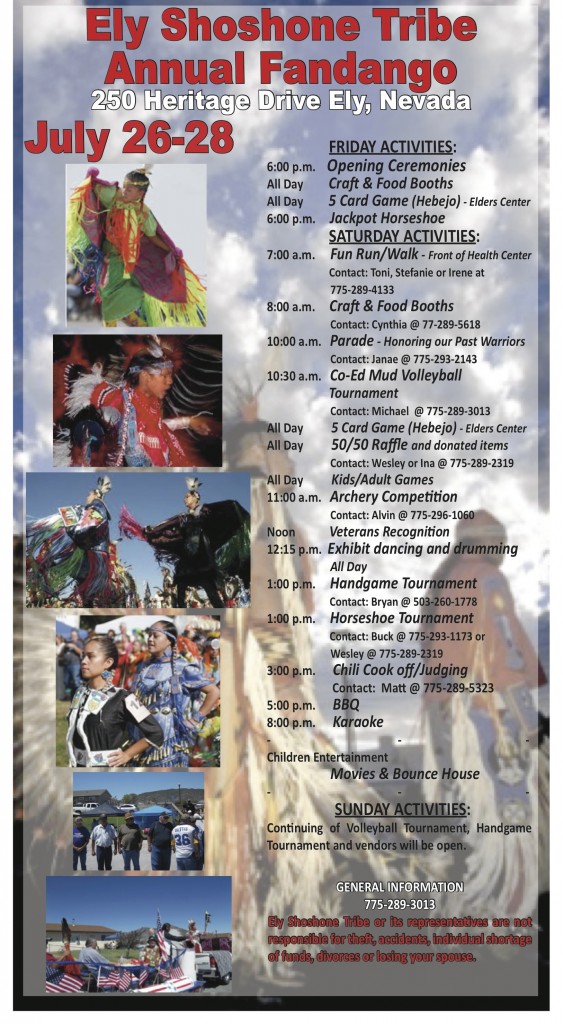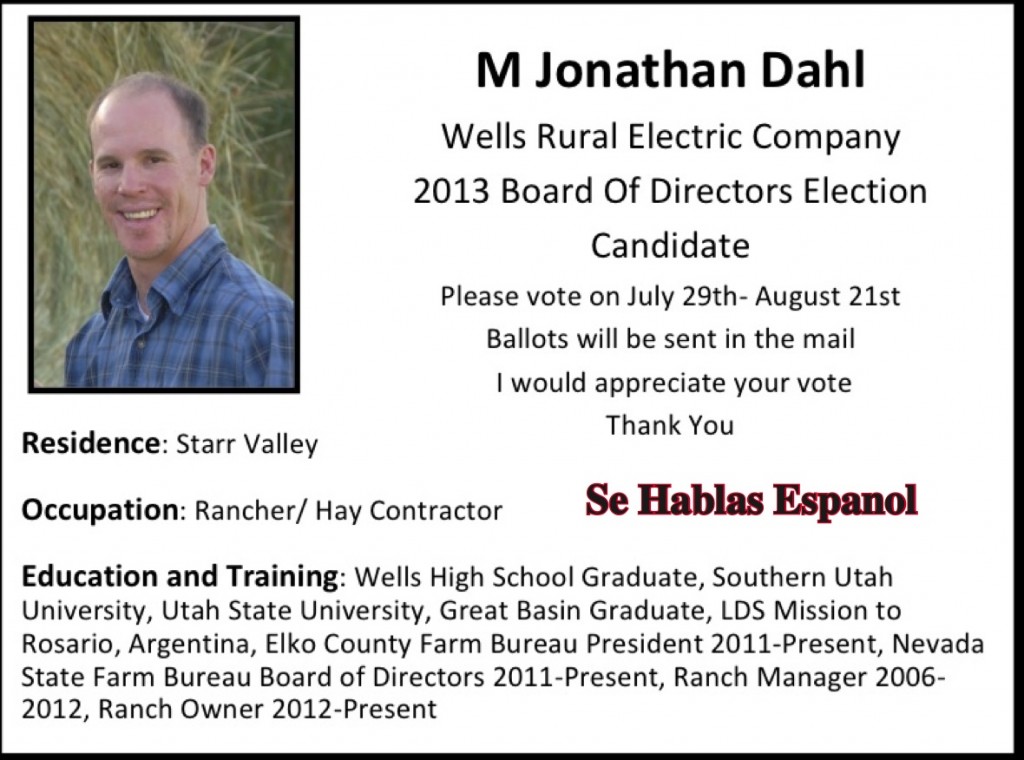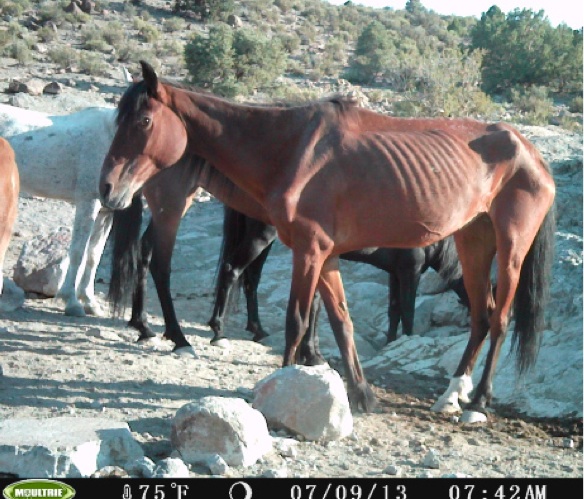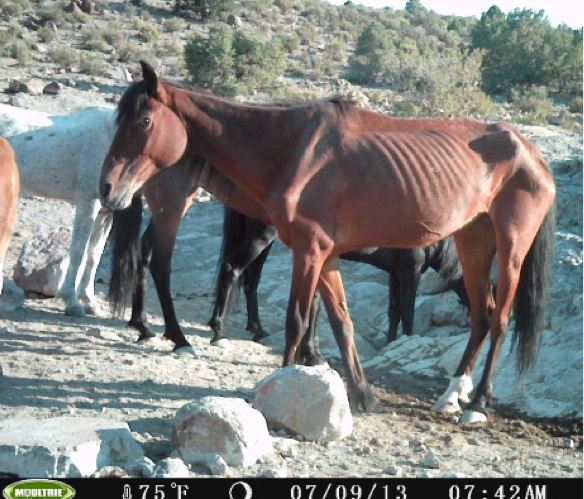By Chris Hanefeld
Public Affairs Specialist BLM
The Bureau of Land Management (BLM) Ely District, Caliente Field Office is scheduled Tuesday, July 23, to begin an emergency helicopter gather to relocate 50 wild horses threatened by severe drought from the Seaman Herd Area (HA) to off-range pastures and facilities.
 Worsening drought conditions in eastern Nevada have resulted in emergency conditions within the Seaman HA that seriously threaten the health and well-being of these wild horses. Although some rainfall has occurred, the moisture has been insufficient to break the drought, which has left extremely limited amounts of water and forage in the area. Henneke body condition scores (BCS) within the Seaman HA range from poor (BCS 1.5) to moderately thin (BCS 4). Wild horses with a BCS of 2 or less are at risk of death if they remain on the range, given the current drought conditions. The BLM estimates that about one third of the horses need to be urgently removed from the area.
Worsening drought conditions in eastern Nevada have resulted in emergency conditions within the Seaman HA that seriously threaten the health and well-being of these wild horses. Although some rainfall has occurred, the moisture has been insufficient to break the drought, which has left extremely limited amounts of water and forage in the area. Henneke body condition scores (BCS) within the Seaman HA range from poor (BCS 1.5) to moderately thin (BCS 4). Wild horses with a BCS of 2 or less are at risk of death if they remain on the range, given the current drought conditions. The BLM estimates that about one third of the horses need to be urgently removed from the area.
The BLM has been closely monitoring drought conditions and since early July has been supplementing the natural water seeps, filling tubs and troughs with water, and providing hay to the horses. Unfortunately, these animals are extremely skittish and will not drink from the man-made containers. Even with the extra water, the seeps do not provide enough water to sustain them.
 The BLM will utilize the services of gather contractor Cattoor Livestock Roundup, Inc., which uses a helicopter to locate and herd wild horses toward a set of corrals. The pilot is assisted by a ground crew and a domesticated horse that is trained to guide the horses into the corral. The use of helicopters has proven to be a safe, effective and practical means by which to gather excess wild horses with minimal anxiety or hardship on the animals, and is authorized by the 1971 Wild Free-Roaming Horses and Burros Act. Although the BLM had considered alternative methods of trapping, veterinarians have advised that due to their rapidly declining health, there is not enough time to individually trap the 50 horses. Horses removed from the range will be transported to the Delta Wild Horse and Burro Facility in Delta, Utah.
The BLM will utilize the services of gather contractor Cattoor Livestock Roundup, Inc., which uses a helicopter to locate and herd wild horses toward a set of corrals. The pilot is assisted by a ground crew and a domesticated horse that is trained to guide the horses into the corral. The use of helicopters has proven to be a safe, effective and practical means by which to gather excess wild horses with minimal anxiety or hardship on the animals, and is authorized by the 1971 Wild Free-Roaming Horses and Burros Act. Although the BLM had considered alternative methods of trapping, veterinarians have advised that due to their rapidly declining health, there is not enough time to individually trap the 50 horses. Horses removed from the range will be transported to the Delta Wild Horse and Burro Facility in Delta, Utah.
During the gather it is anticipated that as an act of mercy, some animals with a poor prognosis for survival may need to be humanely euthanized to end their suffering. Without these actions, it is highly likely that more animals, particularly wet mares and foals, would suffer over time and die if left on the range.
 A Wild Horse Gather Information Line has been established at (775) 861-6700. A recorded message will provide information on daily gather activities and schedules. The BLM will also post daily gather information on its website at www.blm.gov/nv.
A Wild Horse Gather Information Line has been established at (775) 861-6700. A recorded message will provide information on daily gather activities and schedules. The BLM will also post daily gather information on its website at www.blm.gov/nv.
Public lands within the HA will be open to the public during gather operations, subject to necessary safety restrictions, and the BLM will make every effort to allow for public viewing opportunities. Due to the emergency nature of this situation, the BLM appreciates advance notice from visitors wishing to attend the gather. Visitors are encouraged to sign up prior to arriving by calling the Gather Information Hotline (775) 861-6700 and leaving a message.
 The Seaman Herd Area Emergency Wild Horse Gather and its impacts are described and analyzed in the Decision Record, which is available online at www.blm.gov/nv.
The Seaman Herd Area Emergency Wild Horse Gather and its impacts are described and analyzed in the Decision Record, which is available online at www.blm.gov/nv.
The approximately 358,834-acre Seaman HA is located in Lincoln and Nye Counties, about 35 miles south of Lund, Nevada. Seaman is a Herd Area (HA), not a Herd Management Area (HMA). The horses found within the HA are animals that historically have been there, but have never been able to be totally removed from the area following the Land Use Plan decision in 2008 to zero out or not actively manage them. HAs are those geographic areas where wild horses and/or burros were found at the passage of the Wild Horse and Burros Act in 1971. HMAs are those areas within Herd Areas where the decision has been made, through Land Use Plans, to manage for populations of wild horses and/or burros. Seaman was determined to be a Herd Area due to the lack of suitable habitat, specifically inadequate forage or water. HAs, including Seaman, lie within a Mojave Desert transition zone where trees and brush comprise the primary vegetation; relatively few grasses or forbs are present and water is limited.


